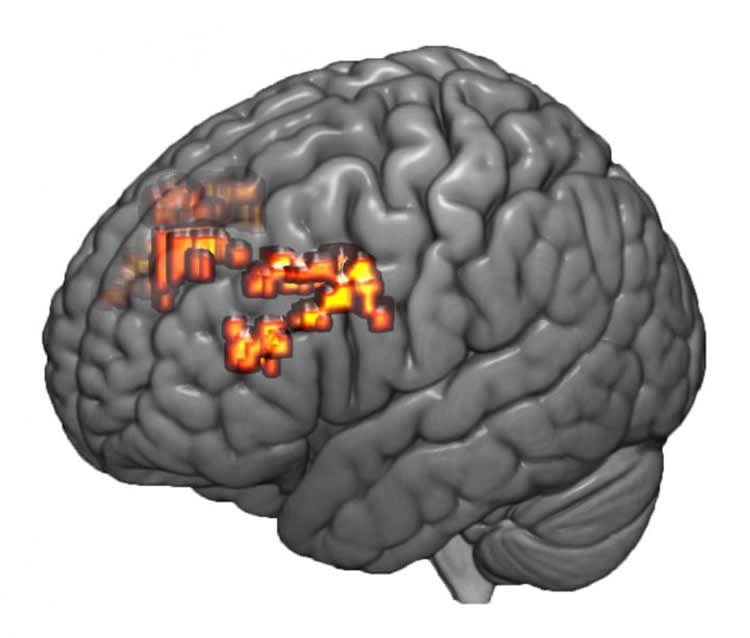Summary: According to researchers, engaging the prefrontal cortex with mental math exercises could help to improve emotional health.
Source: Duke.
New study could inform brain training for better mental health.
Engaging a specific part of the brain during mental math exercises is connected with better emotional health, according to a new brain-scanning study published by Duke researchers in the journal Clinical Psychological Science.
The research takes a preliminary step toward informing new brain training strategies to stave off depression and anxiety. Although the relationship between math and emotion needs further study, the new findings may also lead to new tests gauging the effectiveness of psychological therapies.
“Our work provides the first direct evidence that the ability to regulate emotions like fear and anger reflects the brain’s ability to make numerical calculations in real time,” said Matthew Scult, a neuroscience graduate student in the lab of the study’s senior investigator Ahmad Hariri, a professor of psychology and neuroscience at Duke.
Although they may seem unrelated, doing “cold” calculations and regulating “hot” emotions both rely on similar mental gymnastics: the ability to manipulate and update information. Researchers have long speculated about the link between the two.
In the new study, Hariri’s group analyzed brain activity of 186 undergraduates — using a type of non-invasive brain scan called functional magnetic resonance imaging — while they were doing math problems from memory.
The students are participants in the ongoing Duke Neurogenetics Study, which is exploring relationships between genes, the brain and mental health. In addition to the scans, participants completed questionnaires and interviews assessing their mental health status and emotional coping strategies.
Memory-based math problems stimulate a region of the brain called the dorsolateral prefrontal cortex, which has already been linked to depression and anxiety. Studies have found, for example, that higher activity in this area is associated with fewer symptoms of anxiety and depression. A well-established psychological treatment called cognitive behavioral therapy, which teaches individuals how to re-think negative situations, has also been seen to boost activity in the dorsolateral prefrontal cortex.
In the current study, the more active a person’s dorsolateral prefrontal cortex was while performing mental math, the more likely he or she was to report being able to adapt their thoughts about emotionally difficult situations.
“We don’t know for sure why that is, but it fit into our hypothesis that the ability to do these more complex math problems might allow you to more readily learn how to think about complex emotional situations in different ways,” Scult said. “It is easy to get stuck in one way of thinking.”

Greater activity in the dorsolateral prefrontal cortex also was associated with fewer depression and anxiety symptoms. The difference was especially obvious in people who had been through recent life stressors, such as failing a class. Participants with higher dorsolateral prefrontal activity were also less likely to have a mental illness diagnosis.
It is still unclear whether more actively engaging the brain area with math exercises would lead to better emotional coping strategies or the other way around. The researchers plan to collect the same type of data over a longer time period, to see whether one observation precedes the other.
“We hope, with these and future studies, that we can inform new strategies to help people regulate their emotions, and to prevent symptoms of anxiety and depression from developing in the first place,” Scult said.
Funding: Hariri is a member of the Duke Institute for Brain Sciences. The research was supported by the National Science Foundation Graduate Research Fellowship, the National Institutes of Health (P30DA023026, R01AG049789, R01DA033369, R01AG049789).
Source: Karl Bates – Duke
Image Source: NeuroscienceNews.com image is credited to Annchen R. Knodt.
Original Research: Abstract for “Thinking and Feeling: Individual Differences in Habitual Emotion Regulation and Stress-Related Mood Are Associated With Prefrontal Executive Control” by Matthew A. Scult, Annchen R. Knodt, Johnna R. Swartz, Bartholomew D. Brigidi and Ahmad R. Hariri in Clinical Psychological Science. Published online October 6 2016 doi:10.1177/2167702616654688
[cbtabs][cbtab title=”MLA”]Duke. “Could Mental Math Boost Emotional Health?.” NeuroscienceNews. NeuroscienceNews, 11 October 2016.
<https://neurosciencenews.com/emotional-health-mental-math-5266/>.[/cbtab][cbtab title=”APA”]Duke. (2016, October 11). Could Mental Math Boost Emotional Health?. NeuroscienceNews. Retrieved October 11, 2016 from https://neurosciencenews.com/emotional-health-mental-math-5266/[/cbtab][cbtab title=”Chicago”]Duke. “Could Mental Math Boost Emotional Health?.” https://neurosciencenews.com/emotional-health-mental-math-5266/ (accessed October 11, 2016).[/cbtab][/cbtabs]
Abstract
Thinking and Feeling: Individual Differences in Habitual Emotion Regulation and Stress-Related Mood Are Associated With Prefrontal Executive Control
Calculating math problems from memory may seem unrelated to everyday processing of emotions, but they have more in common than one might think. Prior research highlights the importance of the dorsolateral prefrontal cortex (dlPFC) in executive control, intentional emotion regulation, and experience of dysfunctional mood and anxiety. Although it has been hypothesized that emotion regulation may be related to “cold” (i.e., not emotion-related) executive control, this assertion has not been tested. We address this gap by providing evidence that greater dlPFC activity during cold executive control is associated with increased use of cognitive reappraisal to regulate emotions in everyday life. We then demonstrate that in the presence of increased life stress, increased dlPFC activity is associated with lower mood and anxiety symptoms and clinical diagnoses. Collectively, our results encourage ongoing efforts to understand prefrontal executive control as a possible intervention target for improving emotion regulation in mood and anxiety disorders.
“Thinking and Feeling: Individual Differences in Habitual Emotion Regulation and Stress-Related Mood Are Associated With Prefrontal Executive Control” by Matthew A. Scult, Annchen R. Knodt, Johnna R. Swartz, Bartholomew D. Brigidi and Ahmad R. Hariri in Clinical Psychological Science. Published online October 6 2016 doi:10.1177/2167702616654688






